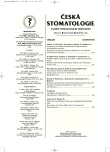Osteonecrosis of the Jaws in Treatment with Bisphosphonates
Authors:
M. Machálka 1; Z. Adam 2; O. Bulik 1; M. Kozumplíková 1
Authors‘ workplace:
Klinika ústní, čelistní a obličejové chirurgie LF MU a FN, Brno
přednosta doc. MUDr. M. Machálka, CSc.
1; Interní hematoonkologická klinika LF MU a FN, Brno
přednosta prof. MUDr. J. Vorlíček, CSc.
2
Published in:
Česká stomatologie / Praktické zubní lékařství, ročník 106, 2006, 5, s. 136-139
Overview
Bisphosphonates are an integral part of the comprehensive treatment strategy in patients in whom either bone metastases arise or bone metabolism disorders occur in terms of osteoporosis. Basic principle of the effect of bisphosphonates consists in their selective trapping in the bones where they create a protective barrier against bone destruction. By reason of interference with the metabolism of triphosphates, bisphosphonates inhibit the bone cells, i.e. osteoclasts and also contain an important anti-angiogenic effect, which is desired against the oncogenous activity. After introducing the bisphosphonates into treatment, initially no effect on quality of bone tissue of the jaw was observed. Nevertheless, some complications may occur after toot extraction. The authors present a file of thirteen patients who were treated with bisphosphonates on a long-term basis in 2003-2005 and in whom complications occurred after the tooth extraction (mainly in the mandible), caused by alveolitis and further increase of bone necrosis. The essence of these complications rests in disorder of the bone tissue vascularization due to the character of nitrogen molecules, which are included in modern bisphosphonates. Initially sharp painful symptoms calmed down after conservative treatment. Nevertheless, the afflicted area did not heal up completely and in some cases extensive ostitis up to osteomyelitis arose. In one case pathological fracture of the mandible occurred. The necrotic, disengaging bone was treated either by surgical intervention, sequestrectomy or by partial resection of the bone without destroying the integrity of the jaw. The character of post-extraction complications is similar to that of complications in case of osteoradionecrosis. When planning surgical treatment, dental surgeon must proceed very carefully and support the patient with an adequate dose of antibiotics. In the course of extraction the surgeon must decrease the vasoconstrictor effects of local anesthetics at the most, dress the wound carefully and protect the blood coagulum created in the wound. If any complications arise, the surgeon must immediately start an intensive long-term antibiotic therapy supported with surgical interventions for removing the necrotic and non-regenerating bone. Analogous to the situation in patients suffering from cancer, in whom first the tooth sanitation and afterwards the irradiation of the jaw will be performed, when planning the treatment by means of bisphosphonates the tooth extraction should be performed in accordance with the preventive time schedule.
Key words:
osteonecrosis – bisphosphonates
Labels
Maxillofacial surgery Orthodontics Dental medicineArticle was published in
Czech Dental Journal

2006 Issue 5
Most read in this issue
- Osteonecrosis of the Jaws in Treatment with Bisphosphonates
- Aspergillomas of Maxillary Sinus
- Resorption of Augmenting Materials Used in Sinus Lift Operation
- Preservation of Alveolar Ridge after Preimplantation Tooth Extraction (A Review)
